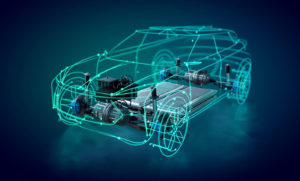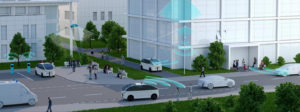 *By Nand Kochhar
*By Nand Kochhar
A general transformation is taking place in the automotive industry. Changes in technology, social issues and environmental regulations are making vehicles more sustainable, safer, more affordable and smarter. In response to these trends and pressures, automakers are doubling down on electrification and continue to invest in developing automated transmission capabilities and autonomous vehicles (AV).
VA development will only become more important in the market if competition continues to increase to produce new and advanced features. Automakers must focus on developing advanced features and functions to stand out in a competitive landscape. With greater emphasis on the advanced capabilities of autonomous vehicles, so are the challenges related to automotive design for engineers.
Automakers will be forced to transform fundamental aspects of their businesses and organizations to meet the needs of the mobility future. Years of development in advanced driver assistance systems (ADAS), vehicle electrification, software, electronic systems and other technologies are coming to fruition, driving a major change in the composition of the automotive market.
There are many automotive design challenges in the future of mobility
Modern vehicles are much more complex now than ten years ago. This increase in complexity is a result of multiple technological developments in the automotive industry. The increasing standardization of Advanced Driver Assistance Systems (ADAS) across the industry has contributed to raising the level of vehicle processing and the number of sensors, actuators and networks in the modern vehicle (Figure 1). Advanced infotainment systems have also become more commonplace, and many now feature connected capabilities to provide enhanced passenger experiences and over-the-air (OTA) upgrades, which further increase the complexity of electrical and electronic (E/E) networks. ), vehicle software, and others.

Figure 1: ADAS features have become standard in the automotive industry, contributing to the increase in electrical, electronic and software content in vehicles. (Image source: iStock)
The power of these processors and the sophistication of the vehicle's software will continue to increase with the development of autonomous driving systems. VAs will incorporate some of the most complex electronic devices ever produced. For example, the SoCs (system on a chip) that provide the vehicle with intelligence are likely to be among the most powerful yet, as they collect and process terabytes of data every second from the various sensor systems surrounding the vehicle.
Vehicle software has also evolved from discrete low-level built-in functions to vehicle-wide software systems that can manage and control various vehicle functions. Autonomous vehicles will have even more complex software that incorporates machine learning and artificial intelligence to process sensor data, make decisions and send instructions around the vehicle in real time. As a result, the various subsystems and domains that make up a VA, from the electronics and software systems to the mechanical systems, will have to continuously interact as the vehicle supports this flow of information around the vehicle.
Even as vehicle complexity increases, companies must integrate all the advanced components and subsystems required for an autonomous driving system into an all-electric vehicle platform while maintaining sufficient driving range and performance characteristics. Some estimates report autonomy reduction of an autonomous driving system of approximately 15% due to the electrical energy demands of the various sensors, actuators and processing devices. Other integration challenges involve ensuring that the vehicle's networks meet the data requirements of a VA and creating an attractive vehicle body such that cameras and sensors are subtle on the outside of the vehicle.
Digitization helps companies meet the challenges of the future
So how can companies overcome the challenges of designing VAs to handle the hundreds of thousands of vehicle subsystem interactions? And how do they understand the potential impacts of a design change throughout the entire product lifecycle, including on manufacturing and supply chain ecosystems?
It all started with the digital transformation of the automotive design process (Figure 2). Digital transformation allows companies to adopt a new approach to the development and engineering of mobility solutions, connecting their entire lifecycle through a digital backbone that allows the flow of information throughout the organization. Partner companies can be securely incorporated into the digital backbone, ensuring faster and easier collaboration between organizations and supporting accountability for overall goals.

Figure 2: Overcoming the complexity of future vehicle designs, whether autonomous or not, starts with digitizing the automotive design process. (Image source: Siemens)
The foundation of this approach is the comprehensive digital twin that captures all aspects of vehicle design and production. With the digital twin, automotive companies can break down barriers between engineering teams in the electrical, electronic, mechanical, and software domains. Not only does this help companies overcome the complexity of VAs, it also fosters a new culture of collaboration and innovation across the enterprise, helping to meet the challenges of the future.
Understanding the big picture
In the first step of designing a new VA, engineers must describe the vehicle's intended behavior, operating environment, and performance goals. In other words, engineers must understand how the VA will operate and how it will interact with the outside world and the ecosystem in which the vehicle will be used (Figure 3). This description includes how various vehicle subsystems will interact, in addition to relevant regulations, manufacturing capabilities and the supply chain. For a VA, this includes the smart infrastructure around the vehicle — smart traffic lights, city traffic management systems, and more.

Figure 3: In the first step of VA design, engineers understand how the VA will operate in its environment and how it will interact with the intelligent infrastructure. (Image source: Siemens)
This process results in a system image of the vehicle's systems and its operating environment. To start the project, this image must be translated into a set of requirements and constraints that describe the project space and the constraints and capabilities the vehicle will require. Traditionally, teams have tried to describe, expand, and decompose these requirements across the organization using a document-based approach. But this approach will not expand to address the complexity of VAs.
Through digitization, those requirements that encode the overall understanding of the project space can be integrated into the product lifecycle, enabling a structured and traceable process of decomposing requirements throughout the organization. The result is a clearer, higher-level detailed picture of what the vehicle needs to do, how it should behave, how big it should be, what kind of performance metrics it needs to meet, and how the various systems will interact. As this high-level description is broken down, engineering teams establish specific goals and constraints to guide the development of each component and subsystem.
For example, a high-level requirement of a VA might require the vehicle to detect objects (other vehicles, infrastructure, pedestrians, etc.) in a 360-degree radius around it. Decomposing this requirement can identify the types of sensors and the amount of each needed to achieve 360-degree awareness and the optimal locations of each on the vehicle body. Further decomposition can identify constraints on the size and placement of these sensors due to packaging, power, thermal properties and others. With these requirements, engineers can begin to design and place the sensors, ensuring that the various requirements and constraints are met.
Digitization facilitates collaboration to address complexity
Digitizing the automotive design process can also improve and speed up the work of the various engineering teams involved in creating a VA. The flow of information in a digitized design process is not unidirectional. Just as requirements and constraints are decomposed and distributed to each of the design teams, component and subsystem design data, simulation results, and changes can be communicated at the vehicle level and across other teams and engineering domains ( Figure 4).

Figure 4: In a digitized vehicle design process, engineering data such as simulation results can flow throughout the organization to all teams involved in the design. (Image source: Siemens)
This ability to communicate quickly and effectively across domains will be critical. VAs will feature highly integrated electronic systems, software, mechanical devices and structures, and the increasingly complicated network architecture linking it all together. Traditionally, each of these systems is developed separately, causing integration problems when they are finally connected. As a result, many companies dedicate up to 50% of the term to the integration processes.
Digitization allows engineering teams, even across OEMs and suppliers, to start working together early in the design process. The digital twins of advanced vehicles enable a digital thread that connects people, designs, models and data to efficiently solve these complex problems. Digitized solutions for electronic circuit design and simulation, mechanical CAD, computational fluid dynamics (CFD), electrical and electronic (E/E) architectures, and more help engineering teams design from a holistic perspective of the vehicle.
Engineering data is available to all teams involved, enabling cross-domain simulations, design optimization, and early verification/validation of design work. As systems are designed and tuned to meet requirements, digital engineering solutions can also help teams evaluate and choose between design options based on cost, thermal properties, power consumption, electronic control unit usage ( ECU), weight and more. Additionally, engineering changes can be quickly communicated to all teams involved, ensuring everyone is up to date throughout the vehicle's program.
The result is a seamlessly integrated system of systems throughout the design and development lifecycle. Issues are resolved as soon as they are identified, causing fewer issues later in the development cycle and faster cycles overall.
Building the future of mobility through digitalization
Overcoming the high complexity of almost all aspects of VA design is becoming one of the great challenges of the future of mobility. Traditional automotive design methodologies that rely on document-based requirements tracing and isolated engineering domains have major shortcomings in dealing with this complexity.
A new approach to vehicle development is needed. VA manufacturers must embrace digitalization and break down barriers between engineering domains and product development stages. The cornerstone of this approach is the overarching digital twin, which captures every aspect of the vehicle's design. With the digital twin, VA manufacturers can connect engineering teams across electrical, electronic, mechanical, and software domains. This means VA manufacturers can design, verify and validate VA platforms, ensuring the highest standards of safety, reliability and passenger comfort.
At the heart of this transformation is the vehicle's comprehensive digital twin concept, which covers every aspect of the vehicle and its environment throughout its lifecycle. This digital twin is the backbone of product development, capable of providing better insights, reducing development cycle time, improving efficiency and increasing market agility.
*Nand Kochhar, Vice President of Automotive and Transportation Strategies at Siemens Digital Industries Software
Notice: The opinion presented in this article is the responsibility of its author and not of ABES - Brazilian Association of Software Companies














